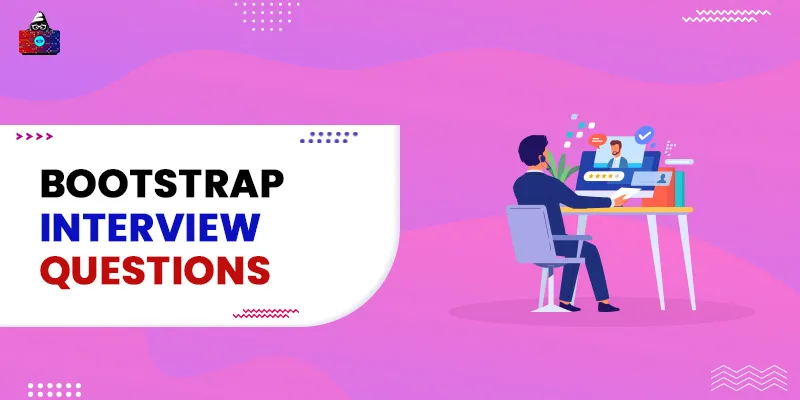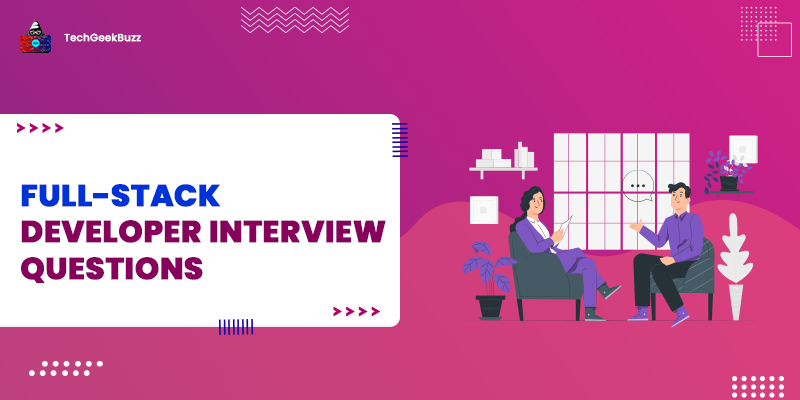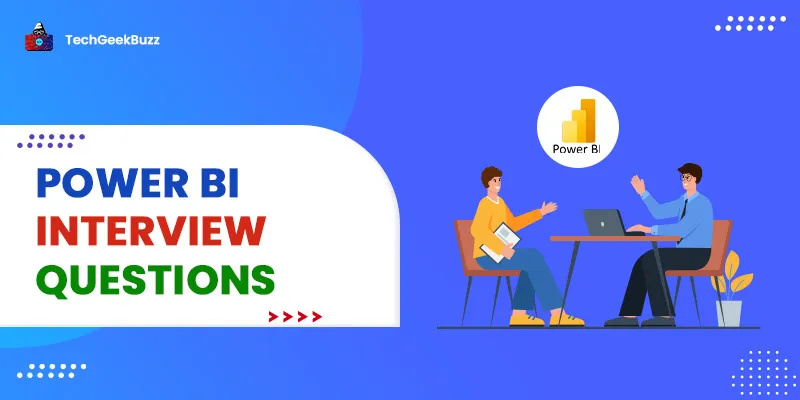Bootstrap is the famous front-end tool for designing web pages, and it includes the three basic components of front-end development, HTML, CSS, and JavaScript, along with jQuery.
If you have added Bootstrap to your CV, then the interviewer would ask you questions related to it. So here, we have provided the best Bootstrap interview questions that you can go through before you appear in the interview.
Many projects that are based on back-end tools use Bootstrap for front-end design. Bootstrap provides pre-written HTML and CSS code that we can simply copy and paste to build an interactive and responsive user interface.
Before you read all the Bootstrap questions and answers, let's discuss how you can crack the Bootstrap interview.
How to Crack a Bootstrap Interview?
Bootstrap is the perfect framework you can start with once you are done with basic HTML, CSS, and JavaScript. It helps you to understand how the front-end framework works and how we can use it in our projects. You are only able to crack the interview if you have some hands-on experience and use Bootstrap in your projects.
Even though Bootstrap is commonly known as a CSS framework, it is, in actuality, a cumulation of HTML, CSS, JavaScript, and jQuery. Thus, during the interview, the interviewer may also ask you questions related to all of these front-end tools. The interviewer may also ask you why you choose Bootstrap when there are other front-end tools that are far better than it.
Here, you can answer according to your experience. Make sure your answer is complete, unambiguous, purely technical, and based on your experience because sometimes an inappropriate response could lead to difficult Bootstrap interview questions.
Bootstrap Interview Questions
Here are frequently asked Bootstrap interview questions categorized into three levels: Beginner-level Bootstrap interview questions, intermediate-level Bootstrap interview questions, and advanced-level Bootstrap interview questions.
Beginner-Level Bootstrap Interview Questions
1. What is Bootstrap?
Answer: It is a CSS framework with JavaScript and a jQuery plugin . With Bootstrap, we can design interactive and dynamic web pages.
2. What is the latest version of Bootstrap?
Answer: The latest release of Bootstrap is Bootstrap5, and the latest version of Bootstrap is 5.1.
3. Why use Bootstrap?
Answer: It is a very flexible framework and provides a mobile-friendly interface. It adjusts the content of the page according to the device display. That’s why many developers prefer to choose Bootstrap for front-end development.
Also, every browser has extensive support for Bootstrap, and with little knowledge of HTML and CSS, we can design a very interactive web page. It also has well-organized documentation with a bunch of examples. Thus, instead of writing code from scratch, we can copy and paste the boilerplate code and extend it.
4. What are the main components of Bootstrap?
Answer: Bootstrap has four main components:
- CSS
- Scaffolding
- Layout
- JavaScript Plugins
5. What are Fixed and Fluid in Bootstrap?
Answer: Fluid and Fixed are the two types of layouts we have in Bootstrap. We use a fluid layout when we want our content to cover all the display width with 100% value. On the other hand, the fixed layout provides a standard screen with 940 px.
6. Explain jumbotron.
Answer: A jumbotron is a class that is used to create a container, which provides a heroic style to all its tags. It increases the size of headings and texts and also provides a margin for its content.
<div class="jumbotron">
7. Explain classloader.
Answer: The class loader is related to Java Runtime Environment . In Bootstrap, it converts the class name to an equivalent binary form at the client-side.
8. What do offset columns do in Bootstrap?
Answer: Offset provides extra features to the columns by pushing columns over. As such, offset columns can provide more spacing in the cell.
9. What are columns ordering in Bootstrap, and how can we achieve it?
Answer: Columns ordering is a feature in Bootstrap by which we can show the columns in any order we want, apart from how we have written them with the HTML tags. To do this, we have two CSS selectors, “ .col-md.push-*” and .”col-md-pull-*” .
10. Which class can we use to wrap content?
Answer: There are many tags in bootstrap that can wrap the content for a specific block. The most famous class is the container class .
“div class="container">
11. What is pagination, and conventionally where do we use it?
Answer: Pagination is a collection of list items. In Bootstrap, we have pagination that can be a list of either ordered or unordered lists. Usually, we use pagination to represent the page number of the web page.
12. What are the tags we can use to display code on the web page?
Answer: To display some code on a webpage, we have two tags:
- <code> ………… </code>
- <pre> ………..</pre>
13. What is the major difference between <code> and <pre> tags?
Answer: The <code> tag renders its content inline while the <pre> tag can show code for multiple lines.
14. How can we show an animated loading bar?
Answer: Bootstrap uses the html5 <process> tag and uses some of its classes to show an animated progress bar.
15. What are the contextual classes in Bootstrap?
Answer: Contextual classes provide a special meaning to their tags by changing their color. There are 5 contextual classes in Bootstrap:
- .active
- .success
- .info
- .danger
- .warning
16. Give some differences between Bootstrap and Foundation.
Answer:
| Bootstrap | Foundation |
| User Interface | |
| Bootstrap has a plethora of user interface components. | Foundation has a limited number of UI components. |
| Values Units | |
| Bootstrap uses px (pixels) as a value unit. | Foundation uses REMs as a value unit. |
| Devices | |
| It is compatible with both mobile and desktop. | It is more about mobile devices. |
| Bootstrap uses LESS as its preprocessor. | Foundation uses SASS and Compass as its preprocessors. |
17. What are breadcrumbs in Bootstrap?
Answer: Breadcrumbs are similar to navbars, but they provide a hierarchical structure by separating the parent and child content.
18. What are alerts in Bootstrap?
Answer: Alerts are the messages and feedbacks given to the user after an action is performed. In Bootstrap, we have an alert to provide different types of messages by changing their color. For example, if we want to tell the user that the action has been performed successfully, we would provide the success alert.
Example:
<div class="alert alert-primary" role="alert"> A simple primary alert—check it out! </div> <div class="alert alert-secondary" role="alert"> A simple secondary alert—check it out! </div> <div class="alert alert-success" role="alert"> A simple success alert—check it out! </div> <div class="alert alert-danger" role="alert"> A simple danger alert—check it out! </div> <div class="alert alert-warning" role="alert"> A simple warning alert—check it out! </div>
19. What is collapsing elements in Bootstrap?
Answer: Collapsing elements in Bootstrap are used to collapse the content by overlaying the main content. With collapse, we can perform the toggle operations with content without embedding JavaScript. With collapse, we can hide and show the content with a click. The class we use to collapse the content is .collapse .
20. Explain carousel plugins in Bootstrap.
Answer: With carousels, we can create sliders on our web page. They provide interactive sliders, and we can move them in left or right directions. To create the sliders on our web page, we can use the .carousel class, and it has many properties, such as:
- (options)
- (‘pause’)
- (‘prev’)
- (‘next’)
- (‘number’)
- (‘cycle’)
21. What are media objects in Bootstrap?
Answer: With Bootstrap, we can add video, audio, and images to our web page and can align those wherever we wish with the help of media objects. To create a media object, we can use the .media class and specify our media source.
Intermediate-Level Bootstrap Interview Questions
22. How can we create Navbars using Bootstrap?
Answer: There are many methods of creating a navbar. For example, we can directly create a navbar using the <nav> tag along with the .navbar class, or we can also use the <div> tag along with the navbar attribute to create a navbar. In Bootstrap, we have different types of navbars, and we can also customize them by adding more links and changing the color.
Example:
<nav class="navbar navbar-light bg-light"> <a class="navbar-brand" href="#">Navbar</a> </nav>
23. Which class can we use to create basic vertical forms?
Answer: We can use the .form-group class to create a vertical form, and the class should be an attribute of the <div> tag. The <div> tag, which contain the form-group class, should be inside the main <form> tag.
Example:
<form> <div class="form-group"> </div> </form>
24. What is the list-group in Bootstrap?
Answer: List-group is a class used along with the list to display a series of content interactively.
Example:
<ul class="list-group"> <li class="list-group-item">A</li> <li class="list-group-item">B</li> <li class="list-group-item">C</li> <li class="list-group-item">D</li> <li class="list-group-item">E</li> </ul>
25. Why do we use badges in Bootstrap?
Answer: We use badges to label something, which is similar to providing some extra information about that content.
Example:
<h1>Example heading <span class="badge badge-secondary">New</span></h1>
26. How can we add a badge inside a list?
Answer: We can add a badge along with the list items or <li> tags.
27. What is a well in Bootstrap?
Answer: It is a container similar to the jumbotron, but it converts the content to the sunken style.
28. Explain media queries in Bootstrap.
Ans: With media queries, we have more access to the media we are showing on our web page. With them, we can hide, show and move media content according to the display size.
29. What is typography?
Answer: In typography, apart from the standard content look, we can change the content font and size using the same tags.
Example:
<p class="h1">h1. Bootstrap heading</p>
30. What are glyphicons in Bootstrap?
Answer: Glyphicons are the icons we use for everyday design works. To add glyphicons, we use the . glyphicon class.
Example:
<span class = "glyphicon glyphicon-search"></span>
31. What is the modal plugin in Bootstrap?
Answer: If we have two different contents to display, and one of those is a parent class and another is a child class, there we can use model plugins. The child content would be treated as a model and layered over the parent window.
32. What are button groups in Bootstrap?
Answer: With button groups, we can create a list of inline buttons and provide different links to each one. To create a group of buttons, we can use the .btn-group class.
Example:
div class="btn-group" role="group" aria-label="Basic example">> <button type="button" class="btn ">1</button> <button type="button" class="btn ">2</button> <button type="button" class="btn ">3</button> <button type="button" class="btn ">4</button> </div>
33. How can we change the button size with the bootstrap class?
Answer: We can use the .btn-group-lg class for large buttons and the .btn-groups-sm class for small buttons.
34. Which class can we use to create pill navigations?
Answer: class = ‘nav-pills’
35. What are the input groups in Bootstrap?
Answer: Input groups are used along with forms to take input from the user. With input groups, we can add the functionality of prepending and appending text or buttons to the text base inputs.
Example:
<div class="input-group flex-nowrap"> <div class="input-group-prepend"> <span class="input-group-text" id="addon-wrapping">#</span> </div> <input type="text" class="form-control" placeholder="Username" aria-label="Username" aria-describedby="addon-wrapping"> </div>
Advanced-level Bootstrap Interview Questions
36. How does the navbar works?
Answer: Navbars are generally used to set meta components at the top of the application display so that the navigation on the application page can be done quickly. Bootstrap provides responsive navbars, which means if your application is opened on a big screen, such as a desktop, then all the components will be shown on the screen. If the page is opened on a mobile device, then all the components will collapse and provide a glyphicon to show all the elements in the horizontal viewport.
37. Explain labels.
Answer:
If we want to provide additional information about any tag or element related content then we can use labels. It is a class represented by
.label
, and can be used for 6 different contextual information:
<span class="label label-default">Default Label</span> <span class="label label-primary">Primary Label</span> <span class="label label-success">Success Label</span> <span class="label label-info">Info Label</span> <span class="label label-warning">Warning Label</span> <span class="label label-danger">Danger Label</span>
38. How can we make images more responsive using Bootstrap?
Answer:
Bootstrap provides a special class called
.img-fluid
to render responsive images, which fit on the user display according to the user device.
<img src="..." class="img-fluid" alt="Responsive image">
39. What is normalize.css in Bootstrap?
Answer: It is a CSS file that is used to solve the problem of browser-specific rendering problems. Although it comes pre-built with Bootstrap, you can also download it separately by using Node Package Manager (npm). Use the following command to use normalize.css:
npm install normalize.css
40. What do panels do in Bootstrap?
Answer: Panels are the classes used along with the <div> tag to bind all the DOM components in a box. They make it easy for DOM objects to retrieve their body elements. For example:
<div class = "panel panel-default">
<div class = "panel-body">
Block of the panel
</div>
</div>
41. How can we give a heading to a panel?
Answer: Bootstrap provides us with two ways to add a panel heading:
-
We can either use the
.panel-headingclass or -
The
.panel-titleclass.
<div class = "panel panel-default">
<div class = "panel-heading">
Panel heading wiht panel-heading class
</div>
<div class = "panel-body">
Panel body
</div>
</div>
<div class = "panel panel-default">
<div class = "panel-heading">
<h3 class = "panel-title">
Panel title
</h3>
</div>
<div class = "panel-body">
Panel body
</div>
</div>
42. What is Scrollspy in Bootstrap?
Answer: It is a plugin that is used to update the current position in the navigation list as we continue to scroll the body of the web page. For example:
<div data-spy="scroll" data-target="#navbar-example2" data-offset="0">
<h4 id="one">About</h4>
<p>About the page........</p>
<h4 id="creators">Creators</h4>
<p>Creators......</p>
<h4 id="summary">Summary</h4>
<p>page summary</p>
</div>
43. What is the Affix plugin in Bootstrap?
Answer: Affix plugins are used to fix an HTML element on the display viewport. It is often used with navbars, so no matter how the user scrolls the pages, the navbar will be fixed at the top of the display.
<div data-spy="affix" data-offset-top="200"> </div> or <nav data-spy="affix" data-offset-top ="190"> navbar body... </nav>
44. Explain the grid system of Bootstrap.
Answer: Bootstrap uses the grid system to place elements on the screen. It divides the complete screen into multiple grids with 12 columns. Using these grids, you can put 12 different frames in a single row. If you want, you can also merge multiple columns of the grid to form a single unit.
div class="row">
<div class="col">Column1</div>
<div class="col">Column2</div>
<div class="col">Column3</div>
<div class="col">Column4</div>
<div class="col">Column5</div>
<div class="col">Column6</div>
<div class="col">Column7</div>
<div class="col">Column8</div>
<div class="col">Column9</div>
<div class="col">Column10</div>
<div class="col">Column11</div>
<div class="col">Column12</div>
</div>
45. Name all the classes used in the Bootstrap grid system.
Answer: Grid classes are used to make Bootstrap more responsive on various devices. These are:
- xs: This grid class is used for mobile devices with less than a 786px wide display.
- sm: This grid class is used for mobile devices like templates with a 786px wide display.
- md: This grid class is used for laptops with a 992px wide display.
- lg: This grid class is used for desktops with a 1200px wide display.
46. What is the default font setting for Bootstrap 4?
Answer: By default, Bootstrap4 uses a font size of 16px with a line height of 1.5. The default font family is "Helvetica Neue," which is a combination of Helvetica, Arial, sans, and serif.
47. Explain the use of the toast class.
Answer: The toast class is similar to the alert box. We can use toast to show a message, which will pop up on the screen. Toast is often used with buttons and submit form icons to provide a feedback message to the user.
<div class="toast"> <div class="toast-header"> Toast Head </div> <div class="toast-body"> message...... </div> </div>
48. What does pagers do in Bootstrap?
Answer: Pagers are part of the pagination, and they are used to provide the next and previous buttons to pagination indexing.
<ul class="pager"> <li><a href="#">Previous</a></li> <li><a href="#">Next</a></li> </ul>
49. How can we change the form input size?
Answer:
Bootstrap comes with two input classes
.input-lg
and
.input-sm
. These two classes can alter the size of the input text.
<input class="form-control input-lg" type="text"> <input class="form-control input-sm" type="text">
50. Explain the tooltip of Bootstrap.
Answer: Tooltip is a plugin that works similarly to the alt attribute. It can be used to show additional popup information about the element content if the mouse hovers over the element.
<a href="#" data-toggle="tooltip" title="Extra info about link">Link</a>
51. What does popover do in Bootstrap?
Answer: popover is similar to the tooltip plugin, but here, instead of hovering over the element, we need to click the element to see the additional information.
<a href="#" data-toggle="popover" title="head" data-content="Additoinal information">Click</a>
52. What can a readonly attribute do in form inputs?
Answer:
If we put the
readonly
attribute in a form, then the user will not be able to fill the form input. The readonly attribute can be used when we do not want to allow the user to fill the input box up to a period.
<input class="form-control" type="text"
placeholder="place holder a value" readonly>
Conclusion
All the Bootstrap interview questions we have provided here will help you to crack the interview. Thus, go through these questions to prepare better for the interview. It's not necessary that the interview you will face will have the exact same questions we have mentioned here. These questions are designed to give you an underlying idea about what kind of Bootstrap questions you can expect during the interview.
If you like this article or have any suggestions for improving it, please let us know by commenting down below.
People are also reading:




